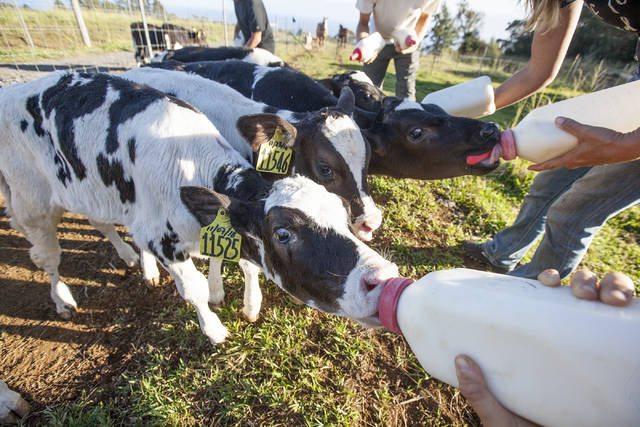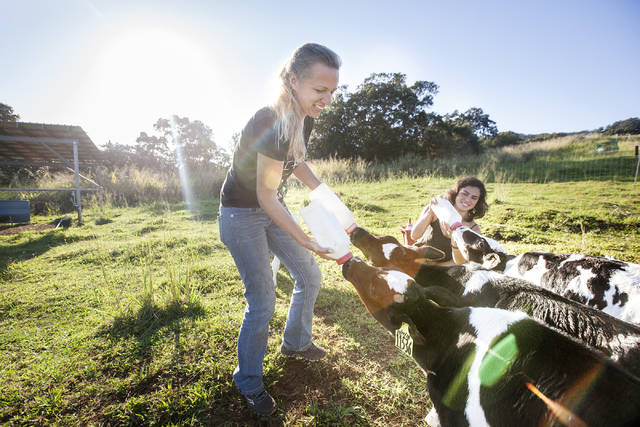As Kinsey Heinrichs opened the gate to Magical Creatures of Hamakua Animal Rescue and Sanctuary on this bright Wednesday morning, three calves followed behind her like eager puppies.
Located in Laupahoehoe on rural, sprawling lands overlooking the Pacific, Magical Creatures — already home to horses, pigs, goats and lambs — earlier this week took in 10 bottle-fed calves that were among 55 purchased from Big Island Dairy, which in November announced the closure of its Ookala facility.
Five will remain at the sanctuary, while five more were set to make it to their new homes Wednesday.
Members of the Hawaii Lava Flow Animal Rescue Network — a group involved in animal rescues during the 2018 Kilauea volcano eruption — came together to buy the animals.
Syndi Texeira, who was involved in planning the effort, said another member of the HLFARN, Alessandra Rupar-Weber, has been “instrumental in pulling all of us back together to do this rescue mission.”
She and Rupar-Weber met with dairy management earlier this month and decided to buy 55 of the dairy’s bottle-fed calves.
“They were very open, very helpful,” she said about the dairy. Management “made it very easy to work with them and plan everything, being that we only had less than a week. And the week deadline was not set by them; it was our goal to get the calves out as soon as possible.”
Within the week, Texeira said the group had to organize and find transportation to take the cows out and deliver them, as well as find enough people willing to adopt.
On Monday, they went and rescued the calves.
“We have actually had about 25 different homes for them,” Texeira said. “Some did fall through at the last minute, (but) we were able to compensate, and others were willing to take in more calves than they had originally asked for.”
Texeira said the group made sure people had enough acreage and experience or help to take care of the calves, and, with the help of the dairy, was able to provide bottles, milk replacement and feed.
“Our goal was set at 55 because when we visited, those were the calves that were bottle-fed,” she said. “… We wanted to remove those first from the dairy, and we figured they would be the easiest to bottle feed and get them to trust humans.”
According to Texeira, the group plans to take more if they’re able, but that depends on funding and other logistics such as having enough trailers and homes for the cows.
“Our goal was to save the animals and have them go to their forever homes or put them in retirement,” Texeira said, adding the group was concerned about the cows going to slaughter or being sold to other dairy farms on the mainland.
Helena Lundblad, who started Magical Creatures a year ago, said she took in a number of animals during the lava emergency last year.
“So, when I was contacted about these guys, I said, ‘Yes! Of course we can take in some babies!’”
Lundblad and several volunteers worked Wednesday morning to feed the calves. Each gets a bottle and a half, twice a day.
“Hi, babies,” she said as she greeted five that remained in the pasture. One mooed in response. When they realized they were about to be fed, the calves crowded close.
“One of my main objectives for the sanctuary is to educate people about the meat and dairy industry …,” Lundblad said. “I want to show people their true personalities and that the animals from the animal agriculture industry are actually individuals, and they have faces, and I just couldn’t stand the thought of them going to slaughter. I want to at least be able to help a few of them.”
The cows now will fulfill “their own purposes,” she said. “They will just be cows. These are all females, so they will just hang out and enjoy life.”
Other calves found homes elsewhere on the Big Island.
Four of the calves will arrive soon at Serenity House, a men’s clean and sober recovery home in Pahoa, where they will be used as part of a therapeutic process.
“Two (of the calves) will stay to raise into cows,” said Rachiel Lehua Javine, a certified substance abuse counselor at Serenity House and program director for Hawaii Support Network, the nonprofit that operates the home. “One of my gentlemen here, who is reintegrating into the community, is a farmer,” and as the other two grow, he will take them home.
Through daily routine, the men will have an opportunity to create a bond “and become therapeutically involved with something other than themselves for emotional growth,” she said.
Another four were adopted by Javine herself, who said she has a farm and fostered animal rescues during last year’s lava disaster in lower Puna.
It was through that connection that the opportunity to rescue the calves came.
“I think they have done an amazing job,” Javine said about the HLFARN. “And it absolutely takes a village. Whether a small part or big part, if everyone who (is able) does what they can, the village can do a lot.”
Texeira, though, said there’s still a “long road ahead of us.”
When reached by phone Tuesday afternoon, dairy manager Steve Manning said about 1,800 cows remain to be sold.
Anyone interested in fostering or adopting a cow through HLFARN or donating to the effort can email hlfarn808@gmail.com.
Email Stephanie Salmons at ssalmons@hawaiitribune-herald.com.





